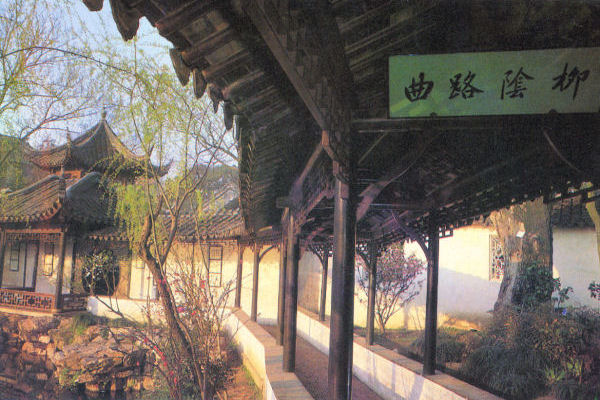
|
The Gardens of Suzhou 10. The Winding Corridor The Winding Corridor of the Humble Administrator's Garden in the City of Suzhou. Largest garden in Suzhou, a Ming Dynasty Mandarin not known for his modesty, built it. As befitting a City of Plentiful Water, ponds make up the better part of the terrain. And where you have ponds, you will find artificial islands, winding bridges, gazebos and weeping willows. A maze of connecting pools and islands, the maze actually consists of only a single, long meandering lake. By the creation of multiple vistas and the dividing of spaces into distinct segments, the artist has expanded the compressed spaces of the garden. ⇦ Back to Page 9 On to Page 11 ⇨Hi-Res Pic (207K) Back to Suzhou - Page 2 |
|
The Humble Administrator's Garden. First laid out in 1509 AD, the garden's scenery is focused on a central pond with various buildings of pavilions, terraces, chambers and towers located by the water or on hillocks in a natural, unsophisticated, and appropriate composition. The garden is most representative of Chinese classical gardens in the Ming Dynasty. The Humble Administrator's Garden covers 4 hectares in northeast Suzhou. It is the largest garden of the city and a typical example of the art of horticulture south of the Changjiang river. The censor Wang Xiancheng laid it out in 1513 after his retirement from political life. He named the garden after an essay by Pan Yue of Jing Era--- "On Idle Living." Building house and planting trees, watering garden and growing vegetables are the affairs (Zheng) of humble (Zhuo) people. After his death, his son gambled away the garden. When Taiping troops occupied Suzhou in 1860, King Zhongwang picked this one and the neighboring buildings of the present Historical Museum as a residence and center for his political activities. Magnificent ponds cover three-fifths of its area. All of the buildings are right next to the ponds, so that the garden seems to be floating on the water. |
|